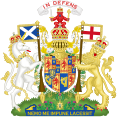List of Scottish monarchs
| Monarchy of Scotland | |
|---|---|
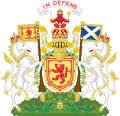 | |
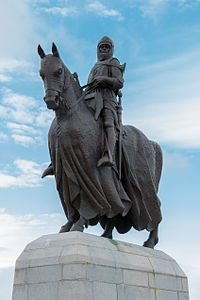 Idealised statue of Robert the Bruce | |
| Details | |
| First monarch | Kenneth I MacAlpin |
| Last monarch | Anne |
| Formation | 843 |
| Abolition | 1 May 1707 |

Pretenders are italicized.
The monarch of Scotland is the head of state of the Kingdom of Scotland. According to tradition, the first King of Scots (Middle Scots: King of Scottis, Modern Scots: King o Scots, Scottish Gaelic: Rìgh na h-Alba) was Kenneth I MacAlpin (Cináed mac Ailpín), who founded the state in 843. The distinction between the Kingdom of Scotland and the Kingdom of the Picts is rather the product of later medieval myth and confusion from a change in nomenclature i.e. Rex Pictorum (King of the Picts) becomes Rí Alban (King of Alba) under Donald II when annals switched from Latin to vernacular around the end of the 9th century, by which time the word Alba in Scottish Gaelic had come to refer to the Kingdom of the Picts rather than Great Britain (its older meaning).[1]
The Kingdom of the Picts just became known as Kingdom of Alba in Scottish Gaelic, which later became known in Scots and English as Scotland; the terms are retained in both languages to this day. By the late 11th century at the very latest, Scottish kings were using the term rex Scottorum, or King of Scots, to refer to themselves in Latin. The Kingdom of Scotland was merged with the Kingdom of England to form a single Kingdom of Great Britain in 1707. Thus Queen Anne became the last monarch of the ancient kingdoms of Scotland and England and the first of Great Britain, although the kingdoms had shared a monarch since 1603 (see Union of the Crowns). Her uncle Charles II was the last monarch to be crowned in Scotland, at Scone in 1651. He had a second coronation in England ten years later.
Heraldry
-
William I – James VI
-
James VI – James VII
-
William II and Mary II
-
Anne
List of monarchs of Scotland
House of Alpin (848–1034)
The reign of Kenneth MacAlpin begins what is often called the House of Alpin, an entirely modern concept. The descendants of Kenneth MacAlpin were divided into two branches; the crown would alternate between the two, the death of a king from one branch often hastened by war or assassination by a pretender from the other. Malcolm II was the last king of the House of Alpin; in his reign, he successfully crushed all opposition to him and, having no sons, was able to pass the crown to his daughter's son, Duncan I, who inaugurated the House of Dunkeld.
| Modern English name (Modern Gaelic name) (Medieval Gaelic name) Reign |
Epithet | Title | Dynastic status |
|---|---|---|---|
| Kenneth I MacAlpin[2] (Coinneach mac Ailpein) (Cináed mac Ailpín / Ciniod m. Ailpin)[3] 843/848 – 13 February 858 |
An Ferbasach, "The Conqueror"[4] |
Rex Pictorum ("King of the Picts") |
son of Alpin king of Dál Riata |
| Donald I[5] (Dòmhnall mac Solein) (Domnall mac Ailpín) 858 – 13 April 862 |
Rex Pictorum |
son of Alpin king of Dál Riata, and brother of Kenneth I | |
| Constantine I[6] (Còiseam mac Choinnich) (Causantín mac Cináeda) 862–877 |
An Finn-Shoichleach, "The Wine-Bountiful"[7] |
Rex Pictorum |
Son of Kenneth I |
| Áed[8] (Aodh mac Choinnich) (Áed mac Cináeda) 877–878 |
Rex Pictorum |
Son of Kenneth I | |
| Giric[9] (Griogair mac Dhunghail) (Giric mac Dúngail) 878–889 |
Mac Rath, "Son of Fortune"[10] |
Rex Pictorum |
Son of Donald I? |
| Eochaid ( ) (Eochaid mac Run) 878–889?* |
Rex Pictorum |
grandson of Kenneth I* | |
| Donald II[11] (Dòmhnall mac Chòiseim) (Domnall mac Causantín) 889–900 |
Dásachtach, "the Madman"[12] |
Rí Alban ("King of Scotland") Rì nan Albannaich ("King of Scots") |
Son of Constantine I |
| Constantine II[13] (Còiseam mac Aoidh) (Causantín mac Áeda) 900–943 |
An Midhaise, "the Middle Aged"[14]
|
Rí Alban Rì nan Albannaich |
Son of Áed |
| Malcolm I[15] (Maol Chaluim mac Dhòmhnaill) (Máel Coluim mac Domnall) 943-954 |
An Bodhbhdercc, "the Dangerous Red"[16] |
Rí Alban Rì nan Albannaich |
Son of Donald II |
| Indulf[17][18] ( ) (Ildulb mac Causantín) 954-962 |
An Ionsaighthigh, "the Aggressor"[19] |
Rí Alban Rì nan Albannaich |
Son of Constantine II |
| Dub / Dubh or Duff[20] (Dub mac Maíl Choluim) (Dubh mac Mhaoil Chaluim) 962–967 |
Dén, "the Vehement"[21] |
Rí Alban Rì nan Albannaich |
Son of Malcolm I |
| Cuilén[22] (Cailean) (Cuilén mac Ilduilb) 967–971 |
An Fionn, "the White"[23] |
Rí Alban Rì nan Albannaich |
Son of Indulf |
| Amlaíb (Amhlaigh) (Amlaíb mac Ilduilb) 973–977¤ |
Rí Alban Rì nan Albannaich |
Son of Indulf | |
| Kenneth II[24] (Coinneach mac Mhaoil Chaluim) (Cináed mac Maíl Choluim) 971–995 |
An Fionnghalach, "the Fratricide"[25] |
Rí Alban Rì nan Albannaich |
Son of Malcolm I |
| Constantine III[26] (Còiseam mac Chailein) (Causantín mac Cuiléin) 995–997 |
Rí Alban Rì nan Albannaich |
Son of Cuilén | |
| Kenneth III[27] (Coinneach mac Dhuibh) (Cináed mac Duib) 997 – 25 March 1005 |
An Donn, "the Chief"/ "the Brown"[28] |
Rí Alban Rì nan Albannaich |
Son of Dub |
| Malcolm II[29] (Maol Chaluim mac Choinnich) (Máel Coluim mac Cináeda) 1005–1034 |
Forranach, "the Destroyer"[30] |
Rí Alban Rì nan Albannaich |
Son of Kenneth II |
*Eochiad was a son of Run, King of Strathclyde, but his mother was a daughter of Kenneth I. Evidence of his reign is unclear. He may have never actually been king and if he was, he was co-king with Giric.
¤Amlaíb is known only by a reference to his death in 977, which reports him as King of Alba; since Kenneth II is known to have still been King in 972–973, Amlaíb must have taken power between 973 and 977.
House of Dunkeld (1034–1286)
Duncan succeeded to the throne as the maternal grandson of Malcolm II. He was also the heir-general of Malcolm I, as his paternal grandfather, Duncan of Atholl was the third son of Malcolm I. The House of Dunkeld was therefore closely related to the House of Alpin. Duncan was killed in battle by Macbeth, who had a long and relatively successful reign. In a series of battles between 1057 and 1058, Duncan's son Malcolm III defeated and killed Macbeth and Macbeth's stepson and heir Lulach, claiming the throne. The dynastic feuds did not end there: on Malcolm III's death in battle, his brother Donald III, known as "Bán", claimed the throne, expelling Malcolm III's sons from Scotland. A civil war in the family ensued, with Donald III and Malcolm III's son Edmund opposed by Malcolm III's English-backed sons, led first by Duncan II and then by Edgar. Edgar triumphed, sending his uncle and brother to monasteries. After the reign of David I, the Scottish throne was passed according to rules of primogeniture, moving from father to son, or where not possible, brother to brother.
| Modern English name (Modern Gaelic name) (Medieval Gaelic name) Reign |
Epithet | Title | Marriage(s) | Dynastic Status |
|---|---|---|---|---|
| Duncan I[31] (Donnchadh mac Crìonain) (Donnchad mac Crínáin) 1034–1040 |
An t-Ilgarach "the Diseased" or "the Sick"[32] |
Rí Alban | Suthen at least two sons |
Grandson of Malcolm II |
| Macbeth[33] (MacBheatha mac Fhionnlaigh) (Mac Bethad mac Findláich) 1040–1057 |
Rí Deircc "the Red King"[34] |
Rí Alban | Gruoch of Scotland no children |
Son of Mormaer Findláech |
| Lulach[35] (Lughlagh mac Gille Chomghain) (Lulach mac Gille Comgaín) 1057–1058 |
Tairbith "the Unfortunate"[34] - Fatuus "the Foolish"[36] |
Rí Alban | Unknown two children |
Son of Gille Coemgáin, Mormaer of Moray and Gruoch of Scotland Step-son of Macbeth |
| Malcolm III[37] (Maol Chaluim mac Dhonnchaidh) (Máel Coluim mac Donnchada) 1058–1093 |
? Cenn Mór ("Canmore") "Great Chief"[38] |
Rí Alban / Scottorum basileus | Ingibiorg Finnsdottir three sons Margaret of Wessex 1070 eight children |
Son of Duncan I |
| Donald III[39] (Dòmhnall mac Dhonnchaidh) (Domnall mac Donnchada) 1093–1097 |
Bán, "the Fair" |
Rí Alban | Unknown at least one daughter |
Son of Duncan I |
| Duncan II[40] (Donnchadh mac Mhaoil Chaluim) (Donnchad mac Maíl Choluim) 1094 |
Rí Alban / Rex Scottorum | Uchtreda of Northumbria one son |
Son of Malcolm III | |
| Edgar[41] (Eagar mac Mhaoil Chaluim) (Étgar mac Maíl Choluim) 1097–1107 |
Probus, "the Valiant"[42] |
Rí Alban / Rex Scottorum | None | Son of Malcolm III |
| Alexander I[43] (Alasdair mac Mhaoil Chaluim) (Alaxandair mac Maíl Choluim) 1107–1124 |
"the Fierce"[44] | Rí Alban / Rex Scottorum | Sybilla of Normandy no children |
Son of Malcolm III |
| David I[45] (Dàibhidh mac Mhaoil Chaluim) (Dabíd mac Maíl Choluim) 1124–1153 |
"the Saint"[46] | Rí Alban / Rex Scottorum | Maud, Countess of Huntingdon 1113 four children |
Son of Malcolm III |
| Malcolm IV[47] (Maol Chaluim mac Eanraig) (Máel Coluim mac Eanric) 1153–1165 |
Virgo "the Maiden" - Cenn Mór, "Great Chief"[38] |
Rí Alban / Rex Scottorum | None | Grandson of David I |
| William I (Uilleam mac Eanraig) (Uilliam mac Eanric) 1165–1214 |
"the Lion" - Garbh, "the Rough"[48] |
Rí Alban / Rex Scottorum | Ermengarde de Beaumont Woodstock Palace, Oxford, England 5 September 1186 four children |
Grandson of David I |
| Alexander II[49] (Alasdair mac Uilleim) (Alaxandair mac Uilliam) 1214–1249 |
Rí Alban / Rex Scottorum | Joan of England York Minster, England 21 June 1221 no children Marie de Coucy Roxburgh 15 May 1239 one son |
Son of William I | |
| Alexander III[50] (Alasdair mac Alasdair) (Alaxandair mac Alaxandair) 1249–1286 |
Rí Alban / Rex Scottorum | Margaret of England York Minster, England 25 December 1251 three children Yolande de Dreux Jedburgh Abbey 15 October 1285 no children |
Son of Alexander II |
House of Sverre (1286–1290)
The status of Margaret, Maid of Norway, as a Scottish monarch is debated by historians. One of her biographers, Archie Duncan, argues that because she was "never inaugurated, she was never queen of Scots". Another, Norman H. Reid, insists that Margaret was "accepted as queen" by her contemporaries but that, owing to the lack of Inauguration, "[her] reign never started".
| Name | Birth | Death | Dynastic status |
|---|---|---|---|
| Margaret[51] the Maid of Norway 1286–1290 |
c. April 1283 Tønsberg, Norway daughter of Eric II of Norway and Margaret of Scotland |
September/October 1290 St Margaret's Hope, Orkney aged 7 |
granddaughter of Alexander III |
First Interregnum (1290–1292)
Monarchy of Scotland restored
House of Balliol (1292–1296)
The death of Margaret of Norway began a two-year interregnum in Scotland caused by a succession crisis. With her death, the descent of William I became extinct and there was no obvious heir. Thirteen candidates presented themselves; the most prominent were John Balliol, great-grandson of William I's younger brother David of Huntingdon, and Robert de Brus, 5th Lord of Annandale, David of Huntingdon's grandson. The Scottish magnates invited Edward I of England to arbitrate the claims. He did so but forced the Scots to swear allegiance to him as overlord. Eventually, it was decided that John Balliol should become king. He proved weak and incapable and, in 1296, was forced to abdicate by Edward I who then attempted to annex Scotland into the Kingdom of England.
| Name | Portrait | Birth | Marriage(s) | Death | Dynastic status |
|---|---|---|---|---|---|
| John Balliol[52] Toom Tabard ("Empty Cloak") (Iain Balliol) 1292–1296 |
 |
c. 1249 | Isabella de Warenne 9 February 1281 at least one son |
great-grandson of David of Huntingdon (brother of William I) |
Second Interregnum (1296–1306)
Monarchy of Scotland restored (second time)
House of Bruce (1306–1371)
For ten years, Scotland had no king. The Scots, however, refused to tolerate English rule. First William Wallace and then John Comyn III and finally Robert the Bruce (the grandson of the 1292 competitor, Robert de Brus, 5th Lord of Annandale) fought against the English. Bruce and his supporters had murdered their rival to the throne of Scotland, John III Comyn, Lord of Badenoch on 10 February 1306 at Greyfriars Church in Dumfries. Shortly after in 1306, Robert was crowned King of Scots at Scone. Robert Bruce was then hunted down for his crime of murder, and subsequently, he escaped to the outskirt islands, leaving the country completely leaderless, and the English invaded once again. Bruce would return a year later and gain support for his cause. His energy, and the corresponding replacement of the vigorous Edward I with his weaker son Edward II in 1307, allowed Scotland to free itself from English rule. At the Battle of Bannockburn in 1314, the Scots routed the English, and by 1328 the English had agreed by treaty to accept Scottish independence. Robert's son, David, acceded to the throne as a child. The English renewed their war with Scotland, and David was forced to flee the kingdom by Edward Balliol, son of King John, who managed to get himself crowned (1332–1356) and to give away Scotland's southern counties to England before being driven out again. David spent much of his life in exile, first in freedom with his ally, France, and then in prison in England. He was only able to return to Scotland in 1357. Upon his death, childless, in 1371, the House of Bruce came to an end.
| Name | Portrait | Birth | Marriage(s) | Death | Dynastic status |
|---|---|---|---|---|---|
| Robert I[53] the Bruce (Raibeart a Briuis) 1306–1329 |
 |
11 July 1274 Turnberry Castle, Ayrshire son of Robert de Brus, 6th Lord of Annandale and Marjorie, Countess of Carrick[54] |
Isabella of Mar 1295 one daughter Elizabeth de Burgh Writtle, Essex, England 1302 four children |
7 June 1329 Manor of Cardross, Dunbartonshire aged 54 |
great-great-grandson of David of Huntingdon (brother of William I) (election) |
| David II[55] (Dàibhidh Bruis) 1329–1371 |
 |
5 March 1324 Dunfermline Palace, Fife son of Robert I and Elizabeth de Burgh |
Joan of England Berwick-upon-Tweed 17 July 1328 no children Margaret Drummond Inchmurdach, Fife 20 February 1364 no children |
22 February 1371 Edinburgh Castle aged 46 |
son of Robert I (primogeniture) |
Disputed claimant
House of Balliol (1332–1356)
Edward Balliol was the son of King John Balliol, who had himself ruled for four years following his election in the Great Cause. Following his abdication, John Balliol lived out his life in obscurity in Picardy, France. During the minority of David II, Edward Balliol seized the opportunity to assert his claim to the throne, and backed by the English, he defeated the forces of David's regency and was himself crowned king at Scone in 1332. He was quickly defeated by loyalist forces and sent back to England. With English support, he would mount two more attempts to seize the throne again, in 1333 and 1335, each time his actual control of the throne was brief before being sent back to England, for the last time in 1336. When David returned from exile in 1341 to rule in his own right, Edward lost most of his support. When David II was captured in battle in 1346, Edward made one last attempt to seize the throne for himself but had little support and the campaign fizzled before it gained much traction. In 1356 he renounced all claims to the throne.
| Name | Portrait | Birth | Marriage(s) | Death | Claim |
|---|---|---|---|---|---|
| Edward Balliol[56] 1332–1356 In opposition to David II |
 |
1283 Son of John Balliol and Isabella de Warenne |
None | 1367 Doncaster, Yorkshire, England aged 83-84 |
Son of John Balliol, candidate of the English to replace the exiled David II |
House of Stewart/Stuart (1371–1651)
Robert the Stewart was a grandson of Robert I by the latter's daughter, Marjorie. Having been born in 1316, he was older than his uncle, David II. Consequently, he was at his accession a middle-aged man, already 55, and unable to reign vigorously, a problem also faced by his son Robert III, who also ascended in middle age at 53 in 1390, and suffered lasting damage in a horse-riding accident. These two were followed by a series of regencies, caused by the youth of the succeeding five boy kings. Consequently, the Stewart era saw periods of royal inertia, during which the nobles usurped power from the crown, followed by periods of personal rule by the monarch, during which he or she would attempt to address the issues created by their minority and the long-term effects of previous reigns. Governing Scotland became increasingly difficult, as the powerful nobility became increasingly intractable. James I's attempts to curb the disorder of the realm ended in his assassination. James III was killed in a civil war between himself and the nobility, led by his son. When James IV, who had governed sternly and suppressed the aristocrats, died in the Battle of Flodden, his wife Margaret Tudor, who had been nominated regent for their young son James V, was unseated by noble feuding, and James V's wife, Mary of Guise, succeeded in ruling Scotland during the regency for her young daughter Mary I only by dividing and conquering the noble factions, distributing French bribes with a liberal hand. Finally, Mary I, the daughter of James V, found herself unable to govern Scotland faced with the surliness of the aristocracy and the intransigence of the population, who favored Calvinism and disapproved of her Catholicism. She was forced to abdicate, and fled to England, where she was imprisoned in various castles and manor houses for eighteen years and finally executed for treason against the English queen Elizabeth I. Upon her abdication, her son, fathered by Henry, Lord Darnley, a junior member of the Stewart family, became King as James VI.
James VI became King of England and Ireland as James I in 1603 when his cousin Elizabeth I died. Thereafter, although the two crowns of England and Scotland remained separate, the monarchy was based chiefly in England. Charles I, James's son, found himself faced with the Civil War. The resultant conflict lasted eight years and ended in his execution. The English Parliament then decreed their monarchy to be at an end. The Scots Parliament, after some deliberation, broke their links with England and declared that Charles II, son, and heir of Charles I, would become King. He ruled until 1651 when the armies of Oliver Cromwell occupied Scotland and drove him into exile.
| Name | Portrait | Birth | Marriage(s) | Death | Dynastic status |
|---|---|---|---|---|---|
| Robert II[57] the Stewart (Raibeart II Stiùbhairt) 1371–1390 |
 |
2 March 1316 Paisley, Renfrewshire son of Walter Stewart, 6th High Steward of Scotland and Marjorie Bruce |
Elizabeth Mure 1336 (uncertain canonicity) 1349 (with Papal dispensation) ten children Euphemia de Ross 2 May 1355 four children |
19 April 1390 Dundonald Castle, Ayrshire aged 74 |
grandson of Robert I (primogeniture) |
| Robert III[58] (born John Stewart) the Lame King (Raibeart III Stiùbhairt, An Righ Bhacaigh) 1390–1406 |
 |
c. 1337 Scone Palace, Perth son of Robert II and Elizabeth Mure |
Anabella Drummond 1367 seven children |
4 April 1406 Rothesay Castle aged about 69 |
son of Robert II (primogeniture) |
| James I[59] (Seumas I Stiùbhairt) 1406–1437 |
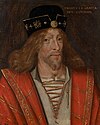 |
late July 1394 Dunfermline Palace, Fife son of Robert III and Anabella Drummond |
Joan Beaufort Southwark Cathedral 2 February 1424 eight children |
21 February 1437 Blackfriars, Perth aged about 42 (assassinated) |
son of Robert III (primogeniture) |
| James II[60] Fiery Face (Seumas II Stiùbhairt) 1437–1460 |
 |
16 October 1430 Holyrood Abbey, Edinburgh son of James I and Joan Beaufort |
Mary of Guelders Holyrood Abbey 3 July 1449 seven children |
3 August 1460 Roxburgh Castle aged 29 |
son of James I (primogeniture) |
| James III[61] (Seumas III Stiùbhairt) 1460–1488 |
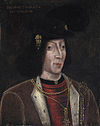 |
10 July 1451 Stirling Castle or St Andrews Castle son of James II and Mary of Guelders |
Margaret of Denmark Holyrood Abbey 13 July 1469 three children |
11 June 1488 Sauchie Burn aged 36 |
son of James II (primogeniture) |
| James IV[62] (Seumas IV Stiùbhairt) 1488–1513 |
 |
17 March 1473 Stirling Castle son of James III and Margaret of Denmark |
Margaret Tudor Holyrood Abbey 8 August 1503 six children |
9 September 1513 Flodden Field, Northumberland, England aged 40 |
son of James III (primogeniture) |
| James V[63] (Seumas V Stiùbhairt) 1513–1542 |
 |
15 April 1512 Linlithgow Palace, West Lothian son of James IV and Margaret Tudor |
Madeleine of Valois Notre Dame Cathedral, Paris, France 1 January 1537 no children Mary of Guise Notre Dame Cathedral, Paris, France 18 May 1538 three children |
14 December 1542 Falkland Palace, Fife aged 30 |
son of James IV (primogeniture) |
| Mary I[64] (Màiri Stiùbhairt) 1542–1567 |
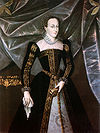 |
8 December 1542 Linlithgow Palace daughter of James V and Mary of Guise |
François II, King of France 24 April 1558 no children Henry Stuart, Lord Darnley Holyrood Palace, Edinburgh 9 July 1565 one child James Hepburn, 4th Earl of Bothwell Holyrood Palace 15 May 1567 no children |
8 February 1587 Fotheringhay Castle, Northamptonshire, England aged 44 (executed) |
daughter of James V (cognatic primogeniture) |
| James VI[65] (Seumas VI Stiùbhairt) 1567–1625 |
 |
19 June 1566 Edinburgh Castle son of Henry Stuart, Lord Darnley and Mary I |
Anne of Denmark Old Bishop's Palace, Oslo, Norway 23 November 1589 seven children |
27 March 1625 Theobalds House, Hertfordshire, England aged 58 |
son of Mary I (primogeniture) |
| Charles I[66] (Teàrlach I Stiùbhairt) 1625–1649 |
 |
19 November 1600 Dunfermline Palace, Dunfermline son of James VI and Anne of Denmark |
Henrietta Maria of France St Augustine's Church, Canterbury, England 13 June 1625 nine children |
30 January 1649 Palace of Whitehall, Westminster, England aged 48 (executed) |
son of James VI (primogeniture) |
| Charles II[67] (Teàrlach II Stiùbhairt) 1649–1651 |
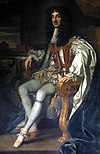 |
29 May 1630 St James's Palace, Westminster, England son of Charles I and Henrietta Maria of France |
Catherine of Braganza Portsmouth, England 14 May 1662 no children |
6 February 1685 Palace of Whitehall, Westminster, England aged 54 |
son of Charles I (primogeniture) |
Third Interregnum (1651–1660)
Monarchy of Scotland restored (third time)
House of Stuart restored (1660–1707)
With the Scottish Restoration, the Stuarts became Kings of Scotland once more but Scotland's rights were not respected. During the reign of Charles II, the Scottish Parliament was dissolved and James was appointed Governor of Scotland. James II himself became James VII in 1685. His Catholicism was not tolerated, and he was driven out of England after three years. In his place came his daughter Mary and her husband William of Orange, the ruler of the Dutch Republic. The two were accepted as monarchs of Scotland after a period of deliberation by the Scottish Parliament and ruled together as William II and Mary II.
An attempt to establish a Scottish colonial empire through the Darien Scheme, in rivalry to that of England, failed, leaving the Scottish nobles who financed the venture for their profit bankrupt. This coincided with the accession of Queen Anne, daughter of James VII. Anne had multiple children but none of these survived her, leaving as her heir her half-brother, James, then living in exile in France. The English favored the Protestant Sophia of Hanover (a granddaughter of James VI) as heir. Many Scots preferred Prince James, who as a Stuart was a Scot by ancestry, and threatened to break the Union of Crowns between England and Scotland by choosing him for themselves. To preserve the union, the English elaborated a plan whereby the two Kingdoms of Scotland and England would merge into a single Kingdom, the Kingdom of Great Britain, ruled by a common monarch, and with a single Parliament. Both national parliaments agreed to this (the Scots albeit reluctantly, motivated primarily by the national finances), and some subterfuge as a total majority of signatories were needed to ratify the Scottish parliament's assent, bribes, and payments. Thereafter, although monarchs continued to rule over the nation of Scotland, they did so first as monarchs of Great Britain, and from 1801 of the United Kingdom.
| Name | Portrait | Birth | Marriage(s) | Death | Dynastic status |
|---|---|---|---|---|---|
| Charles II[67] (Teàrlach II Stiùbhairt) 1660–1685 |
 |
29 May 1630 St James's Palace, Westminster, England son of Charles I and Henrietta Maria of France |
Catherine of Braganza Portsmouth, England 14 May 1662 no children |
6 February 1685 Palace of Whitehall, Westminster, England aged 54 |
son of Charles I (primogeniture) |
| James VII[68] (Seumas VII Stiùbhairt) 1685–1688 |
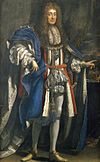 |
14 October 1633 St James's Palace, Westminster, England son of Charles I and Henrietta Maria of France |
Anne Hyde The Strand, London, England 3 September 1660 eight children Mary of Modena Dover, England 21 November 1673 seven children |
16 September 1701 Château de Saint-Germain-en-Laye, France aged 67 |
son of Charles I (primogeniture) |
| Mary II[69] (Màiri II Stiùbhairt) 1689–1694 |
 |
30 April 1662 St James's Palace, England daughter of James VII (II of England) and Anne Hyde |
St James's Palace 4 November 1677 three children (none survived infancy) |
28 December 1694 Kensington Palace, England aged 32 |
grandchildren of Charles I (offered the crown by the Parliament) |
| William II[69] (Uilleam Orains, "William of Orange") 1689–1702 |
 |
4 November 1650 The Hague, Dutch Republic son of William II, Prince of Orange and Mary, Princess Royal |
8 March 1702 Kensington Palace aged 51 |
grandchildren of Charles I (offered the crown by the Parliament) | |
| Anne[70] (Anna Stiùbhairt) 1702–1707 Queen of Great Britain and Ireland 1707–1714 |
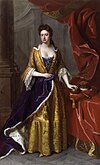 |
6 February 1665 St James's Palace daughter of James VII and Anne Hyde |
George of Denmark St James's Palace 28 July 1683 17 children |
1 August 1714 Kensington Palace aged 49 |
daughter of James VII (primogeniture; Bill of Rights 1689) |
For the British monarchs see List of British monarchs.
Later claimants
James VII continued to claim the thrones of England, Scotland, and Ireland. When he died in 1701, his son James inherited his father's claims and called himself James VIII of Scotland and III of England and Ireland. He would continue to do so all his life, even after the Kingdoms of England and Scotland were ended by their merging as the Kingdom of Great Britain. In 1715, a year after the death of his sister, Queen Anne, and the accession of their cousin George of Hanover, James landed in Scotland and attempted to claim the throne. He failed and was forced to flee back to the Continent. A second attempt by his son, Charles on behalf of his father, in 1745, also failed. Both James's children died without legitimate issue, bringing the Stuart family to an end.
- "James VIII", also known as The Old Pretender, son of James VII, was claimant from 1701 until he died in 1766.
- "Charles III", also known as The Young Pretender and often called Bonnie Prince Charlie, son of James VIII, was claimant from his father's death until his death in 1788 without legitimate issue.
- "Henry I", brother of Charles III and youngest son of James VIII. Died unmarried in 1807.
After 1807, the Jacobite claims passed first to the House of Savoy (1807–1840), then to the Modenese branch of the House of Habsburg-Lorraine (1840–1919), and finally to the House of Wittelsbach (since 1919). The current heir is Franz, Duke of Bavaria. Neither he nor any of his predecessors since 1807 have pursued their claim.
In 1971, Ugandan President Idi Amin declared himself to be the uncrowned king of Scotland,[71] although this claim gained virtually no international recognition.
Timeline of Scottish monarchs

Acts of Union
The Acts of Union were twin Parliamentary Acts passed during 1706 and 1707 by the Parliament of England and the Parliament of Scotland, putting into effect the terms of the Treaty of Union, agreed on 22 July 1706, following prolonged negotiation between Queen Anne's Commissioners representing both parliaments. The Acts joined the Kingdom of England and the Kingdom of Scotland to form a united Kingdom of Great Britain.[72]
Scotland and England had shared a common monarch since the Union of the Crowns in 1603 when the Scottish king James VI succeeded to the English throne. Although described as a Union of Crowns, before the Acts of Union of 1707, the crowns of the two separate kingdoms had rested on the same head. Three unsuccessful attempts (in 1606, 1667, and 1689) were made to unite the two kingdoms by Acts of Parliament, but it was not until the early 18th century that the idea had the will of both political establishments to succeed, thereby bringing the two separate states together under a single parliament as well as a single monarch.
Coronation oath
The coronation oath was sworn by every Scottish monarch from James VI to Charles II and approved by the Estates of Parliament in 1567:
I, N.N., promise faithfully, in the presence of the eternal, my God, that I, enduring the whole Course of my Life, shall serve the same Eternal, my God, to the utmost of my Power, accordingly as he required in his most Holy Word, revealed and contained in the New and Old Testament; and according to the same Word shall maintain the true Religion of Jesus Christ, the preaching of his Holy Word, and due and right administration of his Sacraments, now received and practised within this Realm; and shall abolish and oppose all false Religion contrary to the same; and shall rule the People committed to my Charge, according to the Will and Command of God, revealed in his foresaid Word, and according to the lovable Laws and Constitutions received in this Realm, in no way repugnant to the said Word of the Eternal, my God; and shall procure to my utmost to the Kirk of God and whole Christian people true and perfect Peace in all times coming; the Rights and Rents, with all just privileges of the Crown of Scotland, I shall preserve and keep inviolate, neither shall I transfer nor alienate the same; I shall forbid and repress in all Estates and all Degrees theft, Oppression and all kind of Wrong; in all Judgements, I shall command and procure that Justice and Equity be kept to all creatures without exception, as he be merciful to me and you that is the Lord and Father of all Mercies; and out of all my lands and empire I shall be careful to root out all Heresy and Enemies to the true Worship of God, that shall be convicted by the true Kirk of God of the foresaid Crimes; and these Things above-written I faithfully affirm by my solemn Oath.
The coronation oath is sworn by William II, Mary II and Anne was approved by the Parliament of Scotland on 18 April 1689.[73] The oath was as follows:
WE William and Mary, King and Queen of Scotland, faithfully promise and swear, by this our solemn Oath, in presence of the Eternal God, that during the whole Course of our Life we will serve the same Eternal God, to the uttermost of our Power, according as he has required in his most Holy Word, revealed and contained in the New and Old Testament; and according to the same Word shall maintain the true Religion of Christ Jesus, the preaching of his Holy Word, and the due and right Ministration of the Sacraments, now received and preached within the Realm of Scotland; and shall abolish and gainstand all false Religion contrary to the same, and shall rule the People committed to our Charge, according to the Will and Command of God, revealed in his aforesaid Word, and according to the laudable Laws and Constitutions received in this Realm, no ways repugnant to the said Word of the Eternal God; and shall procure, to the utmost of our power, to the Kirk of God, and whole Christian People, true and perfect Peace in all time coming. That we shall preserve and keep inviolated the Rights and Rents, with all just Privileges of the Crown of Scotland, neither shall we transfer nor alienate the same; that we shall forbid and repress in all Estates and Degrees, Reif, Oppression and all kind of Wrong. And we shall command and procure, that Justice and Equity in all Judgments be kept to all Persons without exception, us the Lord and Father of all Mercies shall be merciful to us. And we shall be careful to root out all Heretics and Enemies to the true Worship of God, that shall be convicted by the true Kirk of God, of the aforesaid Crimes, out of our Lands and Empire of Scotland. And we faithfully affirm the Things above-written by our solemn Oath.
| History of Scotland |
|---|
 |
|
|
See also
- Scottish monarchs' family tree
- Duke of Rothesay – The title of the heir apparent to the Scottish throne.
- Holyrood Palace – The principal residence of the King of Scots.
- His Grace – The style of address used by the King of Scots.
- List of kings of Dál Riata
- List of Kings of the Picts
- List of Kings of Strathclyde
- Earl of Orkney
- Earl of Northumbria
- List of Scottish consorts
- Monarchy of the United Kingdom
- List of British monarchs
- Lord High Commissioner to the Parliament of Scotland
- Lists of monarchs in the British Isles
- List of monarchs of the British Isles by cause of death
- List of legendary kings of Scotland
- List of rulers of the Kingdom of the Isles
- Burial places of British royalty
Notes
- ^ Broun, Scottish Independence. pp. 71–97.
- ^ "Kenneth I (r. 834–858)". royal.gov.uk. Retrieved 1 July 2018.
- ^ Properly speaking, Coinneach should actually be Cionaodh, since Coinneach is historically a separate name. However, in the modern language, both names have converged.
- ^ Skene, Chronicles, p. 83.
- ^ "Donald I (r. 859–863)". royal.gov.uk. Retrieved 1 July 2018.
- ^ "Constantine I (r. 863–877)". royal.gov.uk. Retrieved 1 July 2018.
- ^ Skene, Chronicles, p. 85.
- ^ "Aed (r. 877–878)". royal.gov.uk. Retrieved 1 July 2018.
- ^ "Giric (r. 878–889)". royal.gov.uk. Retrieved 1 July 2018.
- ^ Skene, Chronicles, p. 87.
- ^ "Donald II (r. 889–900)". royal.gov.uk. Retrieved 1 July 2018.
- ^ Hudson, Celtic Kings, p. 58.
- ^ "Constantine II (r. 900–943)". royal.gov.uk. Retrieved 1 July 2018.
- ^ Skene, Chronicles, p. 91; Hudson, Celtic Kings, p. 65.
- ^ "Malcolm I (r. 943–954)". royal.gov.uk. Retrieved 1 July 2018.
- ^ Skene, Chronicles, p. 93.
- ^ "Indulf (r. 954–962)". royal.gov.uk. Retrieved 1 July 2018.
- ^ His name is a Gaelicisation of the Norse name Hildufr (or perhaps English Eadulf); it occurs in various contemporary Gaelic forms, such as Iondolbh, found in the Duan Albanach; Ildulb is used by some historians because it correctly represents the name Hildulfr in Gaelic orthography; Eadwulf would perhaps be Idulb, hence that form is also used sometimes. The name never came into wider use in the Scottish world, or the Gaelic world more generally, and has no modern form. The name "Indulf" is a spelling produced by later medieval French influence; Hudson, Celtic Kings, p, 89.
- ^ Skene, Chronicles, p. 94.
- ^ "Dubh or Duff (r. 962–967)". royal.gov.uk. Retrieved 1 July 2018.
- ^ Duan Albanach, 23 here; as Dub means "Black", "Dub the Black" is tautologous.
- ^ "Culen or Colin (r. 967–971)". royal.gov.uk. Retrieved 1 July 2018.
- ^ Skene, Chronicles, p. 95.
- ^ "Kenneth II (r. 971–995)". royal.gov.uk. Retrieved 1 July 2018.
- ^ Skene, Chronicles, p. 96.
- ^ "Constantine III (r. 995–997)". royal.gov.uk. Retrieved 1 July 2018.
- ^ "Kenneth III (r. 997–1005)". royal.gov.uk. Retrieved 1 July 2018.
- ^ Former probable because later English (speaking) sources called him "Grim"; Old Irish donn has similar meaning to Old Irish greimm, which means "power" or "authority"; see Skene, Chronicles, p. 98; Hudson, Celtic Kings, p. 105.
- ^ "Malcolm II (r. 1005–1034)". royal.gov.uk. Retrieved 1 July 2018.
- ^ Skene, Chronicles, pp. 99–100.
- ^ "Duncan I (r. 1034–1040)". royal.gov.uk. Retrieved 1 July 2018.
- ^ Skene, Chronicles, p. 101.
- ^ "Macbeth (r. 1040–1057)". royal.gov.uk. Retrieved 1 July 2018.
- ^ a b Skene, Chronicles, p. 102.
- ^ "Lulach (r. 1057–1058)". royal.gov.uk. Retrieved 1 July 2018.
- ^ Anderson, Early Sources, vol. i, p. 603.
- ^ "Malcolm III (r. 1058–1093)". royal.gov.uk. Retrieved 1 July 2018.
- ^ a b This name was probably only originally applied to Mael Coluim IV, Mael Coluim III's grandson, and then later confused; see Duncan, Kingship of the Scots, pp. 51–52, 74–75; Oram, David I, p. 17, note 1. Cenn Mór certainly means "great chief" rather than "big head", as sometimes thought.
- ^ "Donald III (r. 1093–1094, 1094-1097)". royal.gov.uk. Retrieved 1 July 2018.
- ^ "Duncan II (r. 1094)". royal.gov.uk. Retrieved 1 July 2018.
- ^ "Edgar (r. 1097-1107)". royal.gov.uk. Retrieved 1 July 2018.
- ^ Anderson, Early Sources, vol. ii, p. 141.
- ^ "Alexander I (r. 1107-1124)". royal.gov.uk. Retrieved 1 July 2018.
- ^ This nickname however is not attested for another three centuries, in the work of Andrew of Wyntoun.
- ^ "David I (r. 1124-1153)". royal.gov.uk. Retrieved 1 July 2018.
- ^ Later nickname. Latin Sanctus also means simply "Holy". David was never canonised.
- ^ "Malcolm IV (r. 1153-1165)". royal.gov.uk. Retrieved 1 July 2018.
- ^ Annals of Ulster, s.a. 1214.6; Annals of Loch Cé, s.a. 1213.10.
- ^ "Alexander II (r. 1214-1249)". royal.gov.uk. Retrieved 1 July 2018.
- ^ "Alexander III (r. 1249-1286)". royal.gov.uk. Retrieved 1 July 2018.
- ^ "Margaret (r. 1286-1290)". royal.gov.uk. Retrieved 1 July 2018.
- ^ "John Balliol (r. 1292-1296)". royal.gov.uk. Retrieved 1 July 2018.
- ^ "Robert I (r. 1306-1329)". royal.gov.uk. Retrieved 1 July 2018.
- ^ Robert The Bruce. Publisher: Heinemann. ISBN 0-431-05883-0.
- ^ "Robert I (r. 1329-1371)". royal.gov.uk. Retrieved 1 July 2018.
- ^ "Edward Balliol (r. for periods 1332-1356)". royal.gov.uk. Retrieved 1 July 2018.
- ^ "Robert II (r. 1371-1390)". royal.gov.uk. Retrieved 1 July 2018.
- ^ "Robert III (r. 1390-1406)". royal.gov.uk. Retrieved 1 July 2018.
- ^ "James I (r. 1406-1437)". royal.gov.uk. Retrieved 1 July 2018.
- ^ "James II (r. 1437-1460)". royal.gov.uk. Retrieved 1 July 2018.
- ^ "James III (r. 1460-1488)". royal.gov.uk. Retrieved 1 July 2018.
- ^ "James IV (r. 1488-1513)". royal.gov.uk. Retrieved 1 July 2018.
- ^ "James V (r. 1513-1542)". royal.gov.uk. Retrieved 1 July 2018.
- ^ "Mary, Queen of Scots (r. 1542-1567)". royal.gov.uk. Retrieved 1 July 2018.
- ^ "James VI and I (r. 1567-1625)". royal.gov.uk. Retrieved 1 July 2018.
- ^ "Charles I (r. 1625-1649)". royal.gov.uk. Retrieved 1 July 2018.
- ^ a b "Charles II (r. 1660-1685)". royal.gov.uk. Retrieved 1 July 2018.
- ^ "James II (r. 1685-1688)". royal.gov.uk. Retrieved 1 July 2018.
- ^ a b "William II and III (r. 1689-1672) and Mary II (r. 1689-1694)". royal.gov.uk. Retrieved 1 July 2018.
- ^ "Anne (r. 1702-1714)". royal.gov.uk. Retrieved 1 July 2018.
- ^ Appiah, Anthony; Henry Louis Gates (1999). Africana: The Encyclopedia of the African and African American Experience.
- ^ Welcome Archived 15 October 2008 at the Wayback Machine parliament.uk, accessed 7 October 2008
- ^ Scottish Parliament Project.
References
- Anderson, Alan Orr, Early Sources of Scottish History: AD 500–1286, 2 Vols, (Edinburgh, 1922)
- Broun, Dauvit (2007), Scottish Independence and the Idea of Britain. From the Picts to Alexander III., Edinburgh University Press, ISBN 978-0-7486-2360-0
- Hudson, Benjamin T., Kings of Celtic Scotland, (Westport, 1994)
- Skene, W. F. (ed.), Chronicles of the Picts, Chronicles of the Scots and other Early Memorials of Scottish History, (Edinburgh, 1867)
External links
- Scottish monarchs
- Scottish monarchy
- Lists of office-holders in Scotland
- Lists of Scottish people
- Lists of monarchs
- Lists of British monarchs
- Scotland-related lists
- Kingdom of Scotland
- Renaissance in Scotland
- 843 establishments
- 9th-century establishments in Scotland
- 1707 disestablishments in Scotland
- Scottish history-related lists



